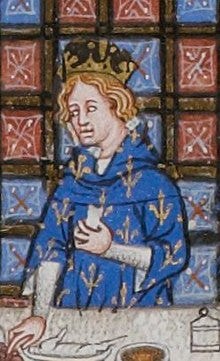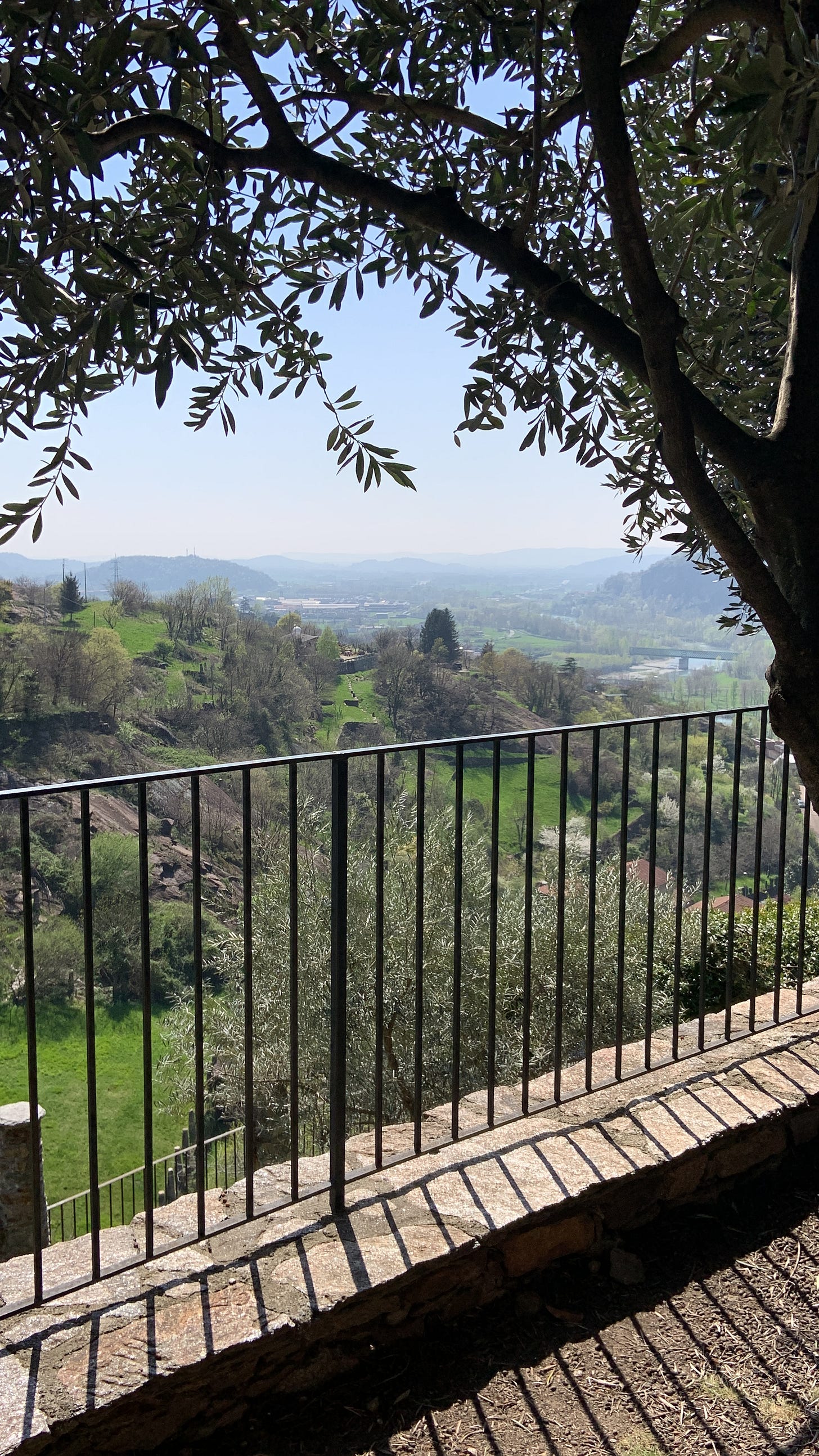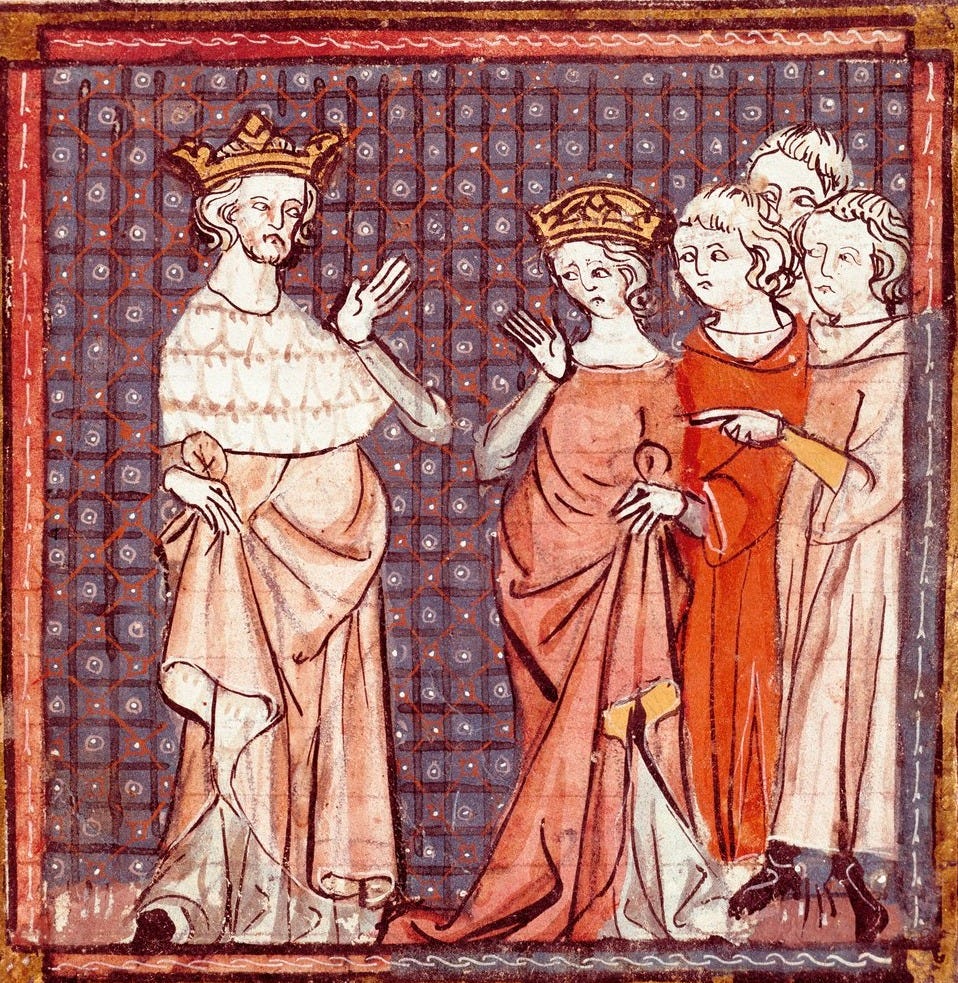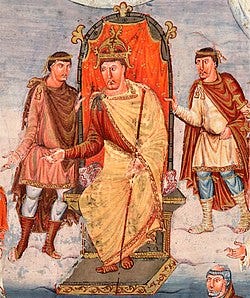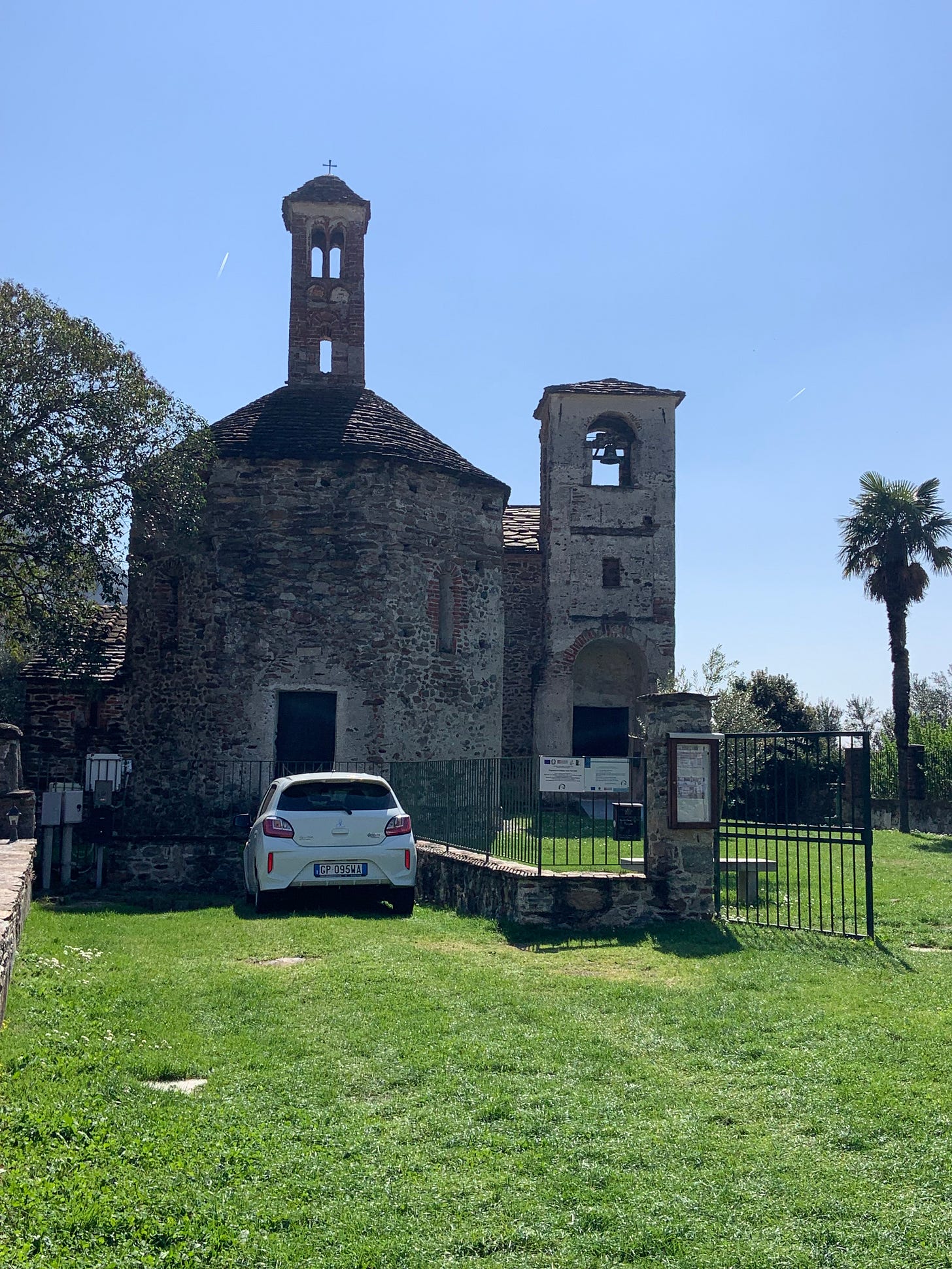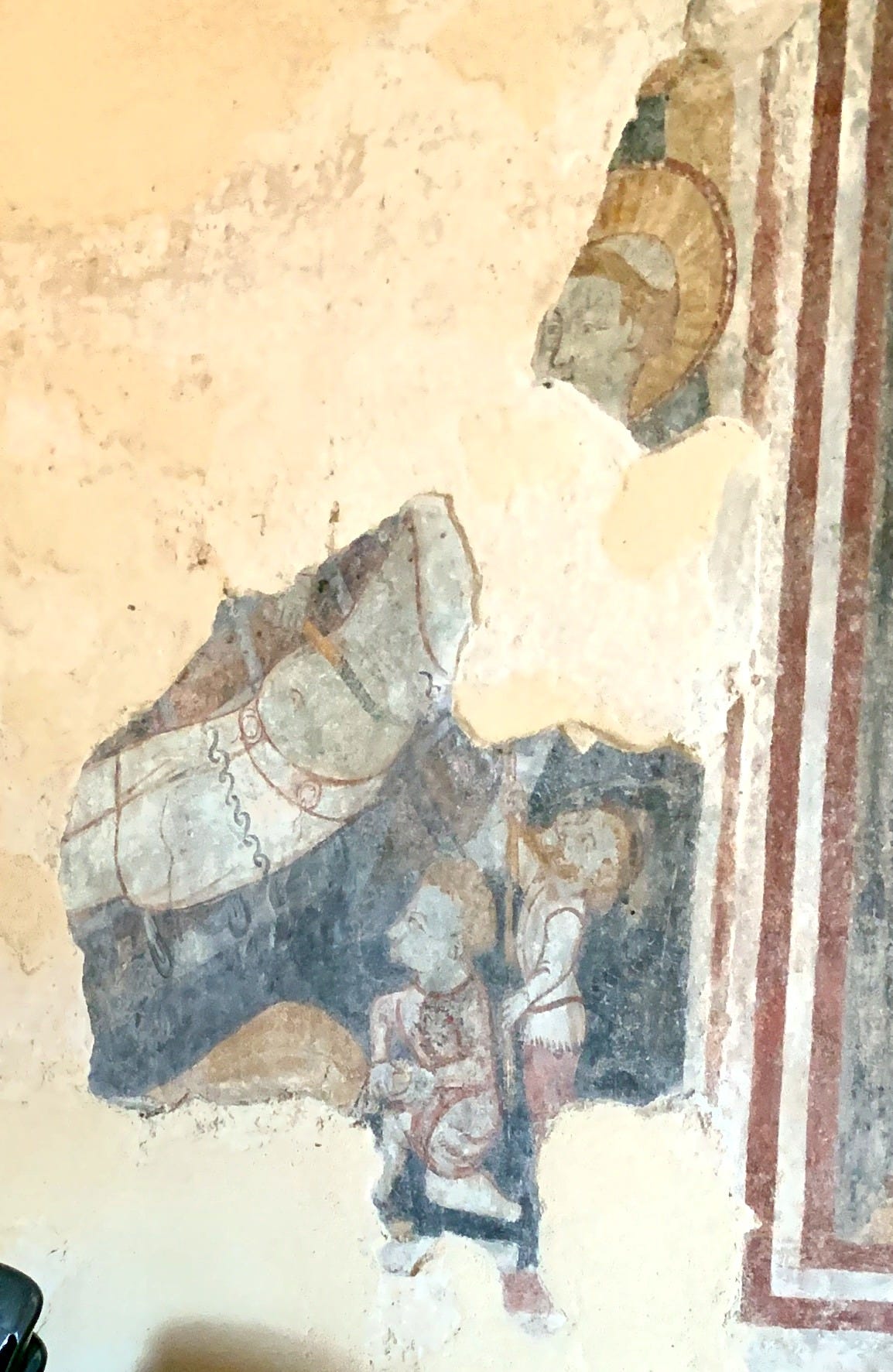How a Queen Outplayed her Father-in-Law and her Husband's Second Wife
In the tender glow of a clandestine March in 862, amidst the formidable landscape of 9th-century Europe, a love story blossomed in defiance of royal decree.
Ansgarda of Burgundy, a woman of graceful strength around thirty-six, found her heart entwined with the youthful Prince Louis, a mere sixteen years of age and heir to the West Frankish throne. Their secret vows, whispered against the cold stone walls, were a passionate rebellion against the ambitions of King Charles the Bald, Louis’s father, who envisioned a politically advantageous match for his son. Yet, bound by a love that dared to defy a king, their union held, a fragile blossom in a world of steel.
I read infinite sources to understand WHY Ansgarda chose Settimo Vittone as her residence and to answer other questions about this village. Settimo Vittone is a lovely, sunny location today, but it’s not a place for a queen accustomed to living in luxury. So, I asked an AI to analyze the case. And in my story, I insert its answers.
Why a 16-Year-Old Prince Married a 36-Year-Old Noblewoman
Frankish “Happily Ever After” (For a While)
She Wasn’t a Nobody: Ansgarda was Burgundian nobility—land-rich, well-connected, and likely politically savvy. For a young Louis, this was a stepping stone to regional support.
Medieval “Cougar” Precedent: Older noblewomen marrying younger heirs wasn’t common, but it happened. Often, the woman brought lands, stability, and mentorship.
Louis’s stammer: His speech impediment might have made him seem “younger”—Ansgarda could have been a steadying force (until Charles the Bald decided otherwise).
For years, Ansgarda graced the courts as Queen of Aquitaine, from 867 to 879, and later held the titular dignity of Queen of the West Franks until 879. Within those years, their love bore fruit, gifting them five precious children – two strong sons, Louis and Carloman, and three daughters – seemingly securing their dynasty with the unbreakable bonds of family. But the currents of royal life were ever shifting, and the whispers of political intrigue soon threatened their idyllic shores.
In 875, the weight of his father’s will pressed heavily upon Louis, now King Louis the Stammerer. With a heart torn, he succumbed to the demands, casting aside his beloved Ansgarda despite the fervent disapproval of Pope John VIII. Stripped of her cherished title, she was banished from the familiar embrace of the court in February of that year, her name deliberately erased from the gilded pages of official records. Yet, within Ansgarda’s spirit burned a fierce love, a mother’s unwavering devotion that refused to be extinguished.
Charles the Bald’s Fury: The Real Reason for the Divorce
Not About Age—About Alliances: By 875, Charles needed a more significant geopolitical play (likely with Italy or the Pope). Ansgarda’s Burgundian ties weren’t enough; he wanted Adelaide of Paris (younger, Carolingian-blooded).
The Ultimate Betrayal: After 10 years and 5 children, Charles forced the divorce against papal wishes—showing Ansgarda (and the Church) that power trumped loyalty.
Ansgarda’s Rightful Rage: Imagine her watching Charles rewrite history, her children bastardized, her jewels handed to Adelaide. Of course, she hated him.
Ansgarda’s marriage wasn’t impossible—just inconvenient for Charles.
When fate cruelly claimed Louis the Stammerer in 879, Ansgarda rose like a lioness defending her cubs. With unwavering resolve, she embarked on a courageous campaign to secure the birthright of her sons. Her voice, filled with a mother’s fierce love, echoed through the halls of power as she implored the Archbishop of Reims to recognize the injustice of her divorce, boldly declaring Louis’s second wife, Adelaide, an adulteress. Her impassioned pleas and undeniable truth prevailed. Before the year drew to a close, her sons, Louis III and Carloman II, were crowned co-kings of France and Aquitaine, a testament to their mother’s indomitable spirit.
But destiny, it seemed, held a cruel hand. The joy was fleeting. In the bloom of youth, Louis III met a tragic end in 882 after a devastating fall from his horse. Just two years later, in 884, Carloman, barely eighteen, perished during a fateful boar hunt. Their untimely deaths extinguished Ansgarda’s direct line, leaving the throne to their cousin, Charles the Fat.
Historical Context: Hunting wasn’t just a sport—it was a public test of strength, divine favor, and virility (especially for Frankish princes). A king who couldn’t kill a boar or bear might be seen as cursed or weak.
With her heart heavy with loss, Ansgarda may have sought solace and refuge in the familiar lands of Piedmont, finding haven with her brother, Anscario I, the Marquis of Ivrea, in the peaceful embrace of Settimo Vittone.
Historical Context: Marquises like Anscario were border warlords—their power came from defending Alpine passes (Ivrea = “key to Italy”).
Far from the treacherous games of the Frankish court, she likely spent her remaining years, her memories a bittersweet tapestry of love and loss. Though records offer varying accounts, it is believed she passed away in either November 880 or 882, though some whispers suggest she lived until 889.
1. Strategic Safety: A Fortified Refuge
Castle of Settimo Vittone: This would have been a highly defensible location if there had already been a castle overlooking the Pieve di San Lorenzo. After being banished from court, Ansgarda needed security—especially if she feared political enemies or reprisals from Adelaide’s faction.
Controlled by Her Brother: Since her brother Anscario I later became Marquis of Ivrea (891), it’s plausible that he already held lands in the region. As a powerful Burgundian-Frankish noble, he could have offered her armed protection in a territory loyal to him.
Alpine Passes & Escape Routes: The Piedmont region was a crossroads between Burgundy, Italy, and Francia. Settimo Vittone was well-positioned if Ansgarda needed to flee further (say, to her Burgundian relatives or even into Switzerland).
2. Family & Political Networks
Anscario’s Rising Power: By the time Ansgarda was exiled (875), her brother had gained influence under Guy of Spoleto, who became King of Italy in 889. Settimo Vittone may have been an early stronghold before he was officially named Marquis.
Burgundian Connections: Burgundy's historical region stretched into northern Italy. If Ansgarda still had family or allies in the Aosta Valley or Ivrea, settling near them would make sense.
Ecclesiastical Ties: The Pieve di San Lorenzo suggests a religious community was present.
3. Symbolism & Legacy
A Quiet Defiance: Settimo Vittone was far from the Frankish court but still within the sphere of Italian politics. By living there, Ansgarda remained close enough to influence events (like her sons’ succession) but safe from direct retaliation.
A Final Resting Place: If she died there (possibly in 880 or 882, or as late as 889), the fact that her ashes were later reburied in San Lorenzo (1657) suggests the location held deep personal or familial significance.
Her brother, Anscario I, carved his formidable path through the annals of history. A Frankish nobleman of unwavering loyalty, he became the first Marquis of Ivrea (891-901), a steadfast supporter of Guy II of Spoleto, and a valiant defender of his lands. He stood firm against invasions and played a pivotal role in the tumultuous politics of his time
This fresco isn’t just art—it’s Ansgarda’s revenge in pigment and plaster. The Church buried her name, but the walls still scream it.
The walls of the church (S.Lorenzo) are covered with frescos. 12th to 16th century. One of them, 13-14 cent., I think it is interesting: The women came to visit the tomb of Christ and saw an angel opening an EARLY medieval sarcophagus. The painter depicts a sarcophagus not in Roman form but some centuries earlier. This probably references that Ansgarda has a resurrection similar to Christ's (there is a stone over the door of the baptistry saying, “Blessed Ansgarda”).
The Church likely tolerated her cult by the 13th–14th century (when the fresco was painted).
Hence the coded fresco: It looks like the Holy Women at Christ’s Tomb… but insiders knew it was Ansgarda’s resurrection.
Early Christians (and medieval pilgrims) inserted hands or cloths into tomb holes to touch relics, seeking healing or blessings. A hole in the side of the sarcophagus was meant for pilgrims to feel the bones of the “blessed” within.
Centuries later, in 1657, a poignant discovery was made. Count Filippo San Martino di Agliè claimed to have unearthed Ansgarda’s ashes, offering them a final resting place in the Church of San Lorenzo in Settimo Vittone. Though the grand narratives of royal history may have sought to erase her name, the enduring power of a mother’s love and her brother's rise ensured that the whispers of Ansgarda of Burgundy echoed softly through the corridors of time. This was a testament to a love that defied a king and a spirit that history could not entirely forget.
Why San Lorenzo? The Hidden Symbolism of Ansgarda’s Church
The dedication of the Pieve di San Lorenzo to Saint Lawrence (San Lorenzo) is far from random—it’s a theological grenade aimed at the Carolingian dynasty that betrayed Ansgarda.
1. Saint Lawrence: The Martyr Who Defied Tyrants
Grilled Alive: Lorenzo was a 3rd-century deacon roasted on an iron grate for defying the Roman Emperor. His legendary last words? "Turn me over—I’m done on this side."
Patron of the Oppressed: He’s the saint of cooks, comedians, and the poor—but also rebels who refuse to bow.
Symbolic Link to Ansgarda:
Like Lorenzo, she was "burned" by power (repudiated, exiled).
Her sarcophagus in his church screams: "Kings martyred me, but I laugh at them from eternity."
2. Carolingian Anxiety About Lorenzo
The Franks hated Lorenzo’s cult because it was huge in Rome—and they were rivals to the Papacy.
By burying Ansgarda here, her allies spat on Charles the Bald’s legacy (he claimed divine right—but Lorenzo died defying divine emperors).
3. The Church’s Secret Resistance
The 13th–14th century fresco of the Holy Women at the Tomb in a Lorenzo-themed church is a double middle finger:
Layer 1: It mirrors Ansgarda’s resurrection cult.
Layer 2: Lorenzo was also buried in a tomb that pilgrims touched—like her sarcophagus hole.
Images are from:
https://www.meisterdrucke.ie/fine-art-prints/French-School/421433/The-Marriage-of-Louis-II-(846-79)-the-Stammerer-and-Adelaide-of-Frioul,-Queen-of-Aquitaine,-from-the-Grandes-Chroniques-de-France-1375-79.html
https://en.wikipedia.org/wiki/Charles_the_Bald
ARE YOU INTERESTED IN OTHER STORIES?
They are here: https://amzn.to/42zESYu with complete descriptions
P.S.
“Either My Son or Nobody” is now available in a third edition in digital formats.
“Those Eyes Behind The Glass Door” is available, too.
You can purchase them here by contacting me for €5.00
I do not have paperbacks.
Please email me at liudmila.books@gmail.com to request my stories and specify your preferred file format. I typically respond within one working day.
I can add dedication on request.





